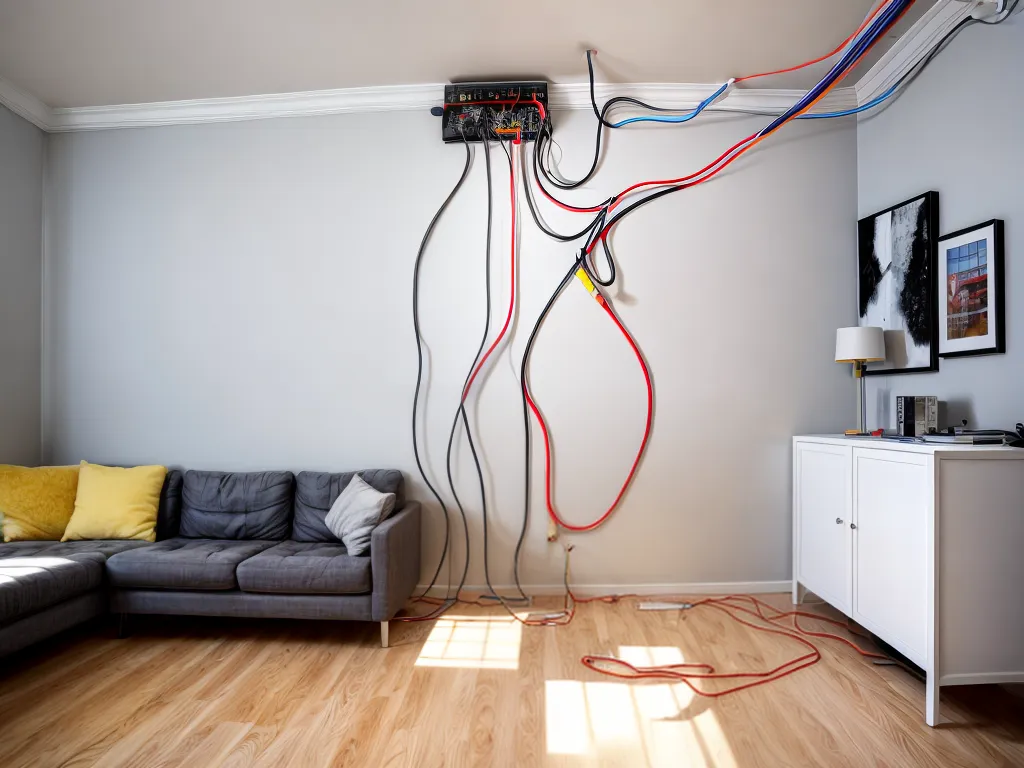
I've decided to rewire my home to upgrade the electrical system, but I don't have any experience doing electrical work. This is a major project that requires knowledge, planning, and extreme caution. Improper electrical work can cause fires, injury, and even death. However, with proper precautions, the right tools, and by following code, I can safely rewire my home without prior electrical experience.
Understanding Electrical Basics Before Rewiring
Before I start tearing into walls and rewiring, it's crucial I understand some electrical fundamentals. This will help me work safely, choose the right materials, and install everything to code. Here are the key concepts I need to know:
Current, Voltage, and Power
- Current is the flow of electrons through a wire, measured in amps.
- Voltage pushes the current, measured in volts.
- More voltage allows more current to flow.
- Power is the rate of energy transfer, measured in watts. Power comes from multiplying current x voltage.
AC and DC Power
- Alternating current (AC) flows back and forth. This is what is supplied to homes.
- Direct current (DC) flows in one direction only. Batteries supply DC power.
Series vs. Parallel Circuits
- In a series circuit, current passes through each component one after another.
- In a parallel circuit, current splits between branches. Home wiring uses parallel circuits.
Conductors, Insulators, and Grounding
- Conductors like copper wire allow current flow.
- Insulators like plastic coatings resist current flow.
- Grounding provides a safe path for accidental currents to flow to the earth. This prevents shocks.
Gathering the Right Materials
To rewire my home, I'll need:
- Wire - I'll use copper wiring with THHN insulation. The gauge (thickness) depends on the expected current.
- Conduit - Rigid metal or PVC tubes house and protect wires.
- Boxes - Plastic or metal junction boxes allow access to connect wires.
- Breakers - Circuit breakers shut off power in overcurrent for safety. My panel size dictates the number of breakers.
- GFCIs - Ground fault circuit interrupters (GFCIs) measure leakage current and prevent shocks. These are required in bathrooms, kitchens, garages, and outside.
- Tools - I'll need strippers, cutters, screwdrivers, a voltage tester, pliers, and crimpers.
For safety, I'll wear electrical gloves and eye protection. I'll also have an electrical fire extinguisher on hand just in case.
Planning the New Wiring Layout
Before touching the existing wiring, it's critical I map out a plan for running the new wires. Key steps in planning include:
- Evaluating the main service panel - Does it provide enough amps for all the home's circuits? Do I need to upgrade the main breaker?
- Considering which rooms need more outlets or lighting - Kitchens, bedrooms, and bathrooms often need more capacity.
- Determining the number of circuits needed - More circuits prevent overloads. I'll follow code for required number of kitchen, bathroom, lighting, etc. circuits.
- Drawing circuit maps showing all wire runs - Each circuit has a hot, neutral, and ground. I'll map where these are run and how they connect.
- Incorporating safety features - This includes GFCIs, AFCIs (circuits to prevent fires), and tamper-resistant outlets.
Careful planning ensures my project meets code and my home's electrical needs are served.
Step-by-Step Process for Rewiring
Once I understand the basics and have a solid plan, I'm ready to replace the old wiring. This is a slow, methodical process. Rushing can lead to mistakes. I'll follow these safe steps:
1. Turn Off Power and Install New Panel
I'll shut off power at the main breaker. Then I'll install the new panel and main shut-off switch. I'll leave it off for now.
2. Remove Old Wiring
Next I'll take out the old wires. I'll discard the antique cloth-wrapped wiring and detach other wires from outlets, switches and fixtures.
3. Run New Wires
Now the fun part - running new wires! I'll feed cables through conduits and drill holes to run wires inside walls. I'll staple cables to studs and continue running wires room to room.
4. Install Outlets, Switches and Fixtures
With the wires run, I'll install all the outlets, switches, junction boxes and fixtures. I'll connect hot, neutral and ground wires securely using screw terminals or wire nuts.
5. Connect Circuits to Panel
I'll label all the circuit breakers clearly. Then I'll connect the Romex cables to the appropriate breakers in the panel. This finishes the electrical pathways.
6. Test and Turn on Power
Before turning the main power back on, I'll test for continuity to ensure wires aren't crossed. Then I'll energize the panel and methodically test each circuit. All outlets and lights should work properly.
Following Codes and Passing Inspection
It's essential all my work complies with the National Electrical Code. Common requirements include:
- Circuit labels - All breakers must be labeled clearly.
- Wire size - Conductors must be sized for expected current. No undersizing wires.
- Boxes - Junction boxes provide access to wires and are required at specific intervals and locations.
- Grounding - All circuits must have proper grounding.
- GFCIs - Outlets near water sources must have GFCI protection.
Once finished, I'll have an inspector verify compliance and certify my rewiring job. This ensures my home meets all safety codes.
Rewiring an entire home is challenging, but absolutely doable for a layperson with proper planning. By understanding basic concepts, gathering the right supplies, creating a plan, taking it slow, and double-checking my work, I can successfully rewire my home without previous experience. I'll save money, gain invaluable skills, and end up with electrical systems that meet my home's needs.